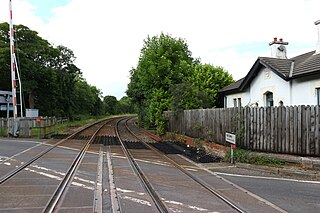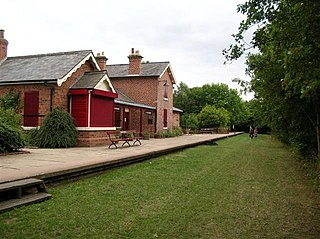
Seaham is a seaside town in County Durham, England. Located on the Durham Coast, Seaham is situated 6 miles south of Sunderland and 13 miles (21 km) east of Durham. The town grew from the late 19th century onwards as a result of investments in its harbour and coal mines. The town is twinned with the German town of Gerlingen.

The North Eastern Railway (NER) was an English railway company. It was incorporated in 1854 by the combination of several existing railway companies. Later, it was amalgamated with other railways to form the London and North Eastern Railway at the Grouping in 1923. Its main line survives to the present day as part of the East Coast Main Line between London and Edinburgh.

The Durham Coast Line is an approximately 39.5-mile (63.6 km) railway line running between Newcastle and Middlesbrough in North East England. Heavy rail passenger services, predominantly operated Northern Trains, and some freight services operate over the whole length of the line; it provides an important diversionary route at times when the East Coast Main Line is closed. Light rail services of the Tyne and Wear Metro's Green Line also operate over the same tracks between a junction just south of Sunderland station and Pelaw Junction.

Sunderland is a railway and metro station in Sunderland, Tyne and Wear, England. It is on the Durham Coast Line, which runs via Hartlepool and the city between Middlesbrough and Newcastle. It is owned by Network Rail and managed by Northern Trains. Since 31 March 2002, the station has also been served by the Tyne and Wear Metro's Green Line.

Stockton is a railway station on the Durham Coast Line, which runs between Newcastle and Middlesbrough via Hartlepool. The station, situated 5 miles 45 chains (9.0 km) west of Middlesbrough, serves the market town of Stockton-on-Tees in County Durham, England. It is owned by Network Rail and managed by Northern Trains.

Seaham is a railway station on the Durham Coast Line, which runs between Newcastle and Middlesbrough via Hartlepool. The station, situated 5 miles 11 chains (8.3 km) south-east of Sunderland, serves the seaside town of Seaham in County Durham, England. It is owned by Network Rail and managed by Northern Trains.

The Clarence Railway was an early railway company that operated in north-east England between 1833 and 1853. The railway was built to take coal from mines in County Durham to ports on the River Tees and was a competitor to the Stockton and Darlington Railway (S&DR). It suffered financial difficulty soon after it opened because traffic was low and the S&DR charged a high rate for transporting coal to the Clarence, and the company was managed by the Exchequer Loan Commissioners after July 1834. An extension of the Byers Green branch was opened in 1839 by the independent West Durham Railway to serve collieries in Weardale.

Ryhope East was one of two railway stations to have served the village of Ryhope, Tyne and Wear, North East England. Opened in 1858 as a stop on the short Londonderry, Seaham and Sunderland Railway, it became a minor stop on the Durham Coast Line following that line's incorporation into it in 1905.

Hartlepool railway station was a railway station that served the Headland area of Hartlepool in the ceremonial county of Durham, North East England. Though originally built as the coastal terminus of the Hartlepool Dock & Railway in 1839, for most of its life the station was the terminus of a shuttle service from the town's main station in West Hartlepool.

Seaham Hall Dene railway station was a private railway station that served Seaham Hall, the then a home of the Marquess of Londonderry close to the town of Seaham, County Durham, England from 1875 to 1925 on the Durham Coast Line.

Horden is a railway station on the Durham Coast Line, which runs between Newcastle and Middlesbrough via Hartlepool. The station, situated 10 miles 74 chains (17.6 km) south-east of Sunderland, serves the villages of Horden, Blackhall Colliery and Easington along with the town of Peterlee in County Durham, North East England. It is owned by Network Rail and managed by Northern Trains.

Blackhall Colliery railway station served the village of Blackhall Colliery in County Durham, North East England. It was located on the Durham Coast Line, north of Blackhall Rocks and south of Horden.

Thorpe Thewles railway station was a railway station on the Castle Eden branch of the North Eastern Railway (NER) from 1880 to 1931. It was located approximately 5 miles north of Stockton and was designed to serve the village of Thorpe Thewles and the civil parish of Grindon in Stockton-on-Tees, part of the Ceremonial County of Durham, North East England but, despite its name, was actually located further from the village of Thorpe Thewles than Carlton station on the main line of the Clarence Railway.

Hurworth Burn railway station was a railway station on the Castle Eden branch of the North Eastern Railway (NER) from 1880 to 1931. It was located between the embankment carrying the railway over Hurworth Burn Reservoir and the bridge carrying the line over the Hart to Trimdon road. As well as serving the then relatively new reservoir, the station primarily served a few scattered hamlets though it was also the nearest station to the village of Sheraton.

Wellfield railway station was a railway station that served the village of Wingate in County Durham, England. It was built by the North Eastern Railway (NER) on the route of the Hartlepool Dock & Railway (HD&R) to allow interchange between the existing line and their newly opened line from Stockton-on-Tees.

Easington railway station served the town of Easington Colliery and Easington Village in County Durham, North East England. It was located on the Durham Coast Line between the stations at Horden and Seaham.

Shotton Bridge railway station was a railway station built by the North Eastern Railway (NER) on the route of the Hartlepool Dock & Railway (HD&R) as part of a programme of works to modernise that line and link it with the Durham & Sunderland Railway (D&SR) so as to create a railway through-route between West Hartlepool and Sunderland. On opening, the station served the relatively new village of Shotton Colliery, which grew around the nearby Shotton Grange Colliery, as well as Old Shotton on the Stockton to Sunderland turnpike road, further to the east.

Ryhoperailway station was one of two railway stations to have served the village of Ryhope, Tyne & Wear. For much of its existence, it was served by the Durham–Sunderland and Hartlepool–Haswell–Sunderland lines.

Hart railway station was a station that served the villages of Hart and Crimdon in County Durham, England.

Blackhall Rocks was one of two railway stations to have served the Blackhalls in County Durham, North East England, and was a stop on the Durham Coast Line. The station was poorly sited for the village that grew around Blackhall Colliery in the years following its opening and, after the opening of the more conveniently sited Blackhall Colliery station in 1936, it came to primarily serve the more southerly village of Blackhall Rocks.




















